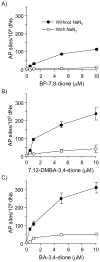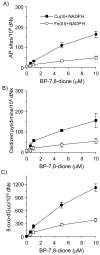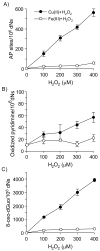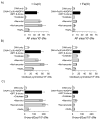Polycyclic aromatic hydrocarbon (PAH) o-quinones produced by the aldo-keto-reductases (AKRs) generate abasic sites, oxidized pyrimidines, and 8-oxo-dGuo via reactive oxygen species
- PMID: 16696575
- PMCID: PMC2366214
- DOI: 10.1021/tx0600245
Polycyclic aromatic hydrocarbon (PAH) o-quinones produced by the aldo-keto-reductases (AKRs) generate abasic sites, oxidized pyrimidines, and 8-oxo-dGuo via reactive oxygen species
Abstract
Reactive and redox-active polycyclic aromatic hydrocarbon (PAH) o-quinones produced by Aldo-Keto Reductases (AKRs) have the potential to cause depurinating adducts leading to the formation of abasic sites and oxidative base lesions. The aldehyde reactive probe (ARP) was used to detect these lesions in calf thymus DNA treated with three PAH o-quinones (BP-7,8-dione, 7,12-DMBA-3,4-dione, and BA-3,4-dione) in the absence and presence of redox-cycling conditions. In the absence of redox-cycling, a modest amount of abasic sites were detected indicating the formation of a low level of covalent o-quinone depurinating adducts (>3.2 x 10(6) dNs). In the presence of NADPH and CuCl2, the three PAH o-quinones increased the formation of abasic sites due to ROS-derived lesions destabilizing the N-glycosidic bond. The predominant source of AP sites, however, was revealed by coupling the assay with human 8-oxoguanine glycosylase (hOGG1) treatment, showing that 8-oxo-dGuo was the major lesion caused by PAH o-quinones. The levels of 8-oxo-dGuo formation were independently validated by HPLC-ECD analysis. Apyrimidinic sites were also revealed by coupling the assay with Escherichia coli (Endo III) treatment showing that oxidized pyrimidines were formed, but to a lesser extent. Different mechanisms were responsible for the formation of the oxidative lesions depending on whether Cu(II) or Fe(III) was used in the redox-cycling conditions. In the presence of Cu(II)-mediated PAH o-quinone redox-cycling, catalase completely suppressed the formation of the lesions, but mannitol and sodium benzoate were without effect. By contrast, sodium azide, which acts as a *OH and 1O2 scavenger, inhibited the formation of all oxidative lesions, suggesting that the ROS responsible was 1O2. However, in the presence of Fe(III)-mediated PAH o-quinone redox-cycling, the *OH radical scavengers and sodium azide consistently attenuated their formation, indicating that the ROS responsible was *OH.
Figures










Similar articles
-
Formation of 8-oxo-7,8-dihydro-2'-deoxyguanosine (8-oxo-dGuo) by PAH o-quinones: involvement of reactive oxygen species and copper(II)/copper(I) redox cycling.Chem Res Toxicol. 2005 Jun;18(6):1026-37. doi: 10.1021/tx050001a. Chem Res Toxicol. 2005. PMID: 15962938 Free PMC article.
-
Specificity of human aldo-keto reductases, NAD(P)H:quinone oxidoreductase, and carbonyl reductases to redox-cycle polycyclic aromatic hydrocarbon diones and 4-hydroxyequilenin-o-quinone.Chem Res Toxicol. 2011 Dec 19;24(12):2153-66. doi: 10.1021/tx200294c. Epub 2011 Sep 29. Chem Res Toxicol. 2011. PMID: 21910479 Free PMC article.
-
Evidence for the aldo-keto reductase pathway of polycyclic aromatic trans-dihydrodiol activation in human lung A549 cells.Proc Natl Acad Sci U S A. 2008 May 13;105(19):6846-51. doi: 10.1073/pnas.0802776105. Epub 2008 May 12. Proc Natl Acad Sci U S A. 2008. PMID: 18474869 Free PMC article.
-
Human aldo-keto reductases and the metabolic activation of polycyclic aromatic hydrocarbons.Chem Res Toxicol. 2014 Nov 17;27(11):1901-17. doi: 10.1021/tx500298n. Epub 2014 Oct 16. Chem Res Toxicol. 2014. PMID: 25279998 Free PMC article. Review.
-
Dihydrodiol dehydrogenase and its role in polycyclic aromatic hydrocarbon metabolism.Chem Biol Interact. 1993 Oct;89(1):1-34. doi: 10.1016/0009-2797(93)03203-7. Chem Biol Interact. 1993. PMID: 8221964 Review.
Cited by
-
Modular, Metal-Catalyzed Cycloisomerization Approach to Angularly Fused Polycyclic Aromatic Hydrocarbons and Their Oxidized Derivatives.J Org Chem. 2015 Aug 7;80(15):7435-46. doi: 10.1021/acs.joc.5b00931. Epub 2015 Jul 21. J Org Chem. 2015. PMID: 26196673 Free PMC article.
-
The Role of Human Aldo-Keto Reductases in the Metabolic Activation and Detoxication of Polycyclic Aromatic Hydrocarbons: Interconversion of PAH Catechols and PAH o-Quinones.Front Pharmacol. 2012 Nov 16;3:193. doi: 10.3389/fphar.2012.00193. eCollection 2012. Front Pharmacol. 2012. PMID: 23162467 Free PMC article.
-
Metabolites of Tobacco- and E-Cigarette-Related Nitrosamines Can Drive Cu2+-Mediated DNA Oxidation.Chem Res Toxicol. 2020 Aug 17;33(8):2072-2086. doi: 10.1021/acs.chemrestox.0c00027. Epub 2020 Aug 4. Chem Res Toxicol. 2020. PMID: 32672941 Free PMC article.
-
Lesion processing: high-fidelity versus lesion-bypass DNA polymerases.Trends Biochem Sci. 2008 May;33(5):209-19. doi: 10.1016/j.tibs.2008.02.004. Epub 2008 Apr 11. Trends Biochem Sci. 2008. PMID: 18407502 Free PMC article. Review.
-
Classifying polycyclic aromatic hydrocarbons by carcinogenic potency using in vitro biosignatures.Toxicol In Vitro. 2020 Dec;69:104991. doi: 10.1016/j.tiv.2020.104991. Epub 2020 Sep 2. Toxicol In Vitro. 2020. PMID: 32890658 Free PMC article.
References
-
- Xue W, Warshawsky D. Metabolic activation of polycyclic and heterocyclic aromatic hydrocarbons and DNA damage. Toxicol Appl Pharmacol. 2005;206:73–93. - PubMed
-
- Rothman N, Poirier MC, Baser ME, Hansen JA, Gentile C, Bowman ED, Strickland PT. Formation of polycyclic aromatic hydrocarbon-DNA adducts in peripheral white blood cells during consumption of charcoal-broiled beef. Carcinogenesis. 1990;11:1241–1243. - PubMed
-
- Denissenko MF, Pao A, Tang M, Pfeifer GP. Preferential formation of benzo[a]pyrene adducts at lung cancer mutational hotspots in P53. Science. 1996;274:430–432. - PubMed
-
- Gelboin HV. Benzo[a]pyrene metabolism, activation and carcinogenesis: role and regulation of mixed function oxidases and related enzymes. Physiol Rev. 1980;60:1107–1166. - PubMed
-
- Conney AH. Induction of microsomal enzymes by foreign chemicals and carcinogenesis by polycyclic aromatic hydrocarbons. G H A Clowes Memorial Lecture. Cancer Res. 1982;42:4875–4917. - PubMed
Publication types
MeSH terms
Substances
Grants and funding
LinkOut - more resources
Full Text Sources
Research Materials
Miscellaneous

